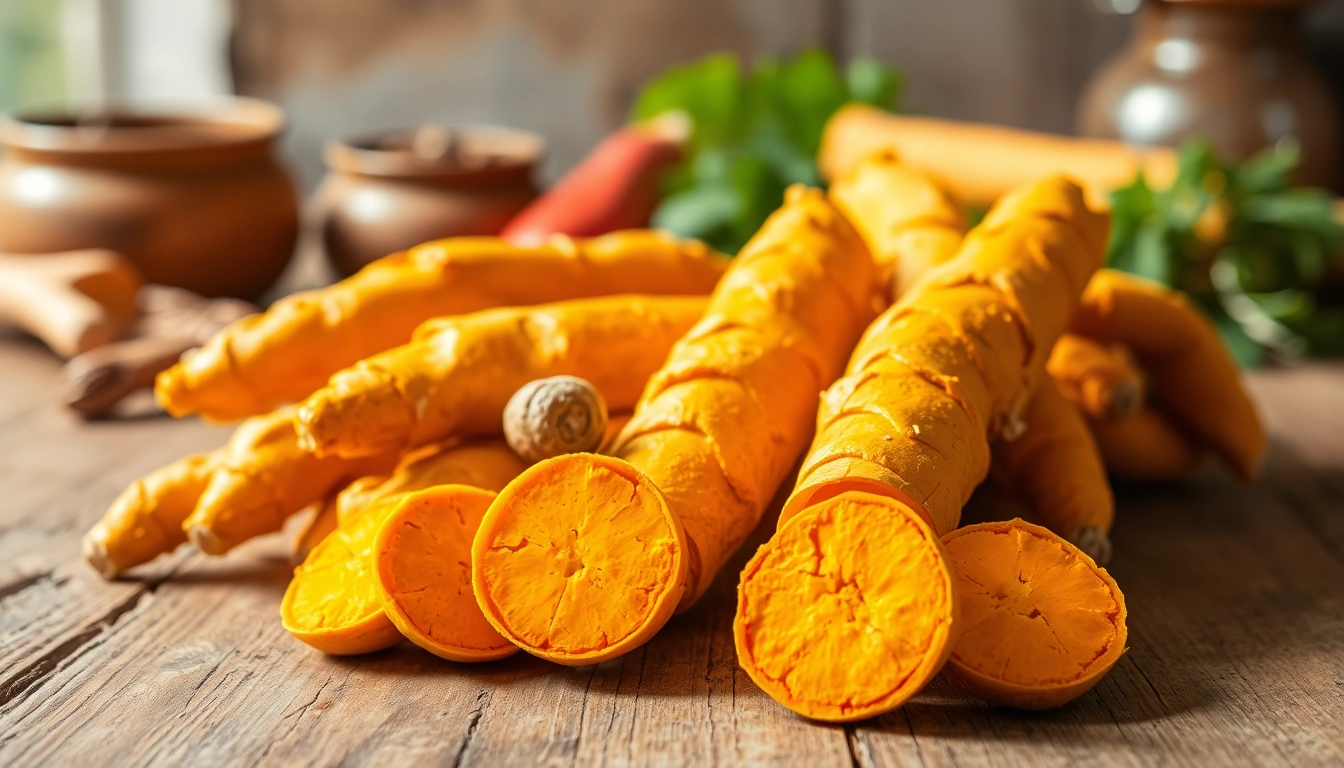The Basics of Turmeric Root
What is Turmeric Root?
Turmeric root, scientifically known as Curcuma longa, is a perennial plant belonging to the ginger family, Zingiberaceae. Its rhizomes, or underground stems, have been used for centuries not just as a culinary spice, but also for their medicinal properties. The vibrant yellow-orange hue of turmeric, which comes from its curcumin content, has made it a popular ingredient in various cuisines, particularly in South Asian cooking. Furthermore, turmeric root has gained recognition in the West due to its numerous health benefits, which have been emphasized in both scientific studies and traditional knowledge.
Botanical Background and Growing Conditions
Turmeric is native to Southeast Asia and requires a warm climate to thrive. It is typically cultivated in tropical and subtropical regions. The plant can grow up to three feet tall, producing large, green leaves that can reach lengths of up to 2 feet. Underground, the rhizomes develop in clusters and can vary significantly in size and shape. Ideal growth conditions for turmeric include well-drained, fertile soil along with high humidity and regular rainfall. Harvesting usually occurs approximately 8 to 10 months after planting when the leaves begin to yellow and die back.
How is Turmeric Root Used in Cooking?
In culinary applications, turmeric root can be used fresh, dried, or powdered. Fresh turmeric can be grated or sliced and added to various dishes for its vibrant color and earthy flavor. It works wonderfully in curries, soups, and stews, providing not only taste but also a rich golden color. Conversely, dried and ground turmeric is often used in spice blends, marinades, and even baking. Its unique flavor profile, which has been described as slightly bitter, warm, and peppery, enhances a variety of dishes, from savory to sweet. Additionally, turmeric is often paired with black pepper to increase the bioavailability of curcumin, the compound responsible for its numerous health benefits.
Health Benefits of Turmeric Root
Nutritional Profile of Turmeric Root
Turmeric root is low in calories while being rich in essential vitamins and minerals. A typical serving contains manganese, iron, and vitamin B6 along with dietary fiber. What’s particularly noteworthy is its high content of curcumin, which boasts extensive antioxidant and anti-inflammatory properties. This intriguing compound has breathed new life into scientific inquiry, making turmeric a hot topic for health enthusiasts and researchers alike.
Anti-inflammatory and Antioxidant Properties
Curcumin is well-known for its potent anti-inflammatory effects. Studies have indicated that curcumin can suppress the activity of various inflammatory molecules in the body, which can be beneficial for those suffering from chronic inflammatory diseases such as arthritis. Furthermore, turmeric root’s antioxidant properties help neutralize free radicals, potentially reducing oxidative stress and the risk of chronic diseases such as cancer and heart disease. This property’s synergistic relationship with other compounds found in turmeric enhances its effectiveness in combating inflammation and oxidative damage.
Potential Health Conditions Affected by Turmeric Root
Research into turmeric root has suggested its potential benefits for a range of health conditions. Studies have indicated that it may help alleviate symptoms associated with arthritis, digestive disorders, and even depression. Its anti-inflammatory properties contribute to its use as a natural remedy for chronic pain and inflammation. Furthermore, some investigations suggest that turmeric may have anti-cancer properties due to its ability to inhibit the growth of cancer cells and induce apoptosis, or programmed cell death. However, while these findings are promising, they should be understood in conjunction with further research and not as definitive cures.
Regular integration of turmeric root into the diet can also support liver health, boost gut health, and improve skin conditions such as psoriasis and acne. Overall, the potential health benefits of turmeric root are vast, making it a valuable addition to any wellness regimen.
How to Incorporate Turmeric Root into Your Diet
Cooking Techniques for Turmeric Root
Incorporating turmeric root into your meals can be both enjoyable and easy. Here are some popular methods:
- Grating: Fresh turmeric can be grated similarly to ginger and added to stir-fries or salads.
- Infusing: Turmeric root can be steeped in hot water to create a herbal tea. Adding honey or lemon can enhance the flavor.
- Powdering: Dried turmeric root can be ground to use in spice mixes or to season roasted vegetables, rice, or legumes.
- Marinades: Turmeric can be included in marinades for meats, tofu, or vegetables, infusing them with flavor and color.
Creative Recipes Featuring Turmeric Root
Here are a few simple and delicious recipes that highlight turmeric root:
Turmeric Rice
This aromatic dish enhances plain rice with the vibrant flavor of turmeric. Start by sautéing chopped onion and garlic in olive oil, stir in grated turmeric root, and then add rinsed rice. Pour in vegetable broth, bring to a boil, and then simmer until fully cooked.
Golden Milk
This soothing beverage combines warm milk with turmeric, ginger, black pepper, and honey. Heat milk, whisk in grated turmeric and ginger, and sweeten to taste. This drink is not only delicious but also acts as a natural anti-inflammatory remedy.
Turmeric-Infused Smoothie
Add a piece of fresh turmeric root to your morning smoothie for an earthy flavor and a boost of nutrients. Combine with banana, spinach, almond milk, and a dash of cinnamon for a nutritious start to your day.
Tips for Storing and Selecting Quality Turmeric Root
When selecting turmeric root, look for firm, unblemished pieces. The skin should be smooth, and the color should be a vibrant orange or yellow. Store fresh turmeric in the refrigerator, wrapped in a paper towel and then placed in a sealed bag to maintain humidity. It can last up to a few weeks when properly stored. Dried turmeric should be kept in an airtight container, away from light and moisture, to retain its potency and flavor.
Scientific Research on Turmeric Root
Recent Studies on Health Benefits
Recent studies have reinforced the traditional beliefs surrounding turmeric’s health benefits. For instance, a systematic review highlighted curcumin’s promise in alleviating the symptoms of arthritis by reducing pain and improving joint function over a sustained period. Another fascinating study suggested that turmeric could play a role in preventing cognitive decline due to its neuroprotective properties. The ongoing research aims to further elucidate these effects and establish clinical guidelines for turmeric supplementation strategies.
Understanding Curcumin and Its Effects
Curcumin not only contributes to turmeric’s health benefits but also poses challenges in absorption by the body. To counteract this, it is often recommended to combine turmeric with black pepper, which contains piperine— a compound known to enhance curcumin absorption by up to 2000%. This synergy is essential for maximizing the potential health benefits of turmeric root.
Common Myths and Misconceptions
Despite its popularity, several myths surround turmeric and its benefits. One such misconception is that turmeric alone is a miracle cure. While it has numerous health benefits, it should not replace conventional treatments prescribed by healthcare professionals. Additionally, some claim that all forms of turmeric provide the same benefits—this is misleading, as fresh and dried turmeric vary in potency and bioavailability. Educating oneself about the proper use and benefits of turmeric is essential for maximizing its health potential.
Purchasing Turmeric Root
Where to Buy Fresh and Dried Turmeric Root
Turmeric root can be purchased at local grocery stores, specialty spice shops, or health food stores. Online retailers also offer a variety of turmeric products—both fresh and dried. A reliable source is Turmeric Root, which ensures high-quality options suitable for culinary and health purposes. When sourcing, it’s advisable to check the origin and quality to ensure optimal product integrity.
Evaluating Quality and Purity
When selecting turmeric root, consider both organic and non-organic sources. Organic turmeric often undergoes less processing and is free from harmful pesticides, making it a healthier option. Additionally, look for products labeled as “curcumin-rich” or “standardized,” indicating higher concentrations of the beneficial compound. Always read ingredient lists to avoid additives that can dilute the product’s efficacy.
Cost Comparison and Buying in Bulk
The cost of turmeric varies depending on form and quality. Fresh turmeric root is typically more expensive than dried turmeric powder, but buying in bulk can lead to savings. For those who frequently use turmeric, purchasing larger quantities can be economical, especially when sourced from reputable suppliers. Consider buying dried turmeric in bulk from local or online health food stores to ensure a good price to quality ratio.



